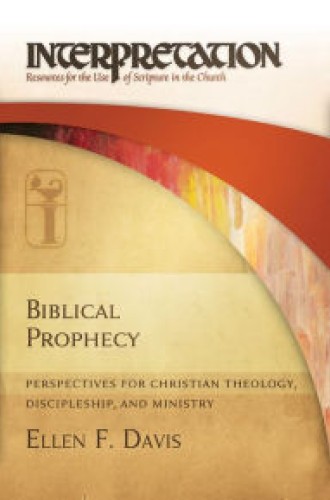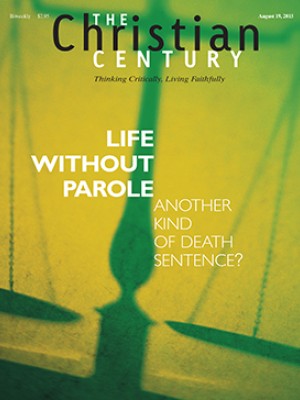Biblical Prophecy, by Ellen F. Davis
Ellen Davis is full of surprises. Some are delightful, and others raise questions for further thought and study. Still others throw up stumbling blocks for her readers.
A professor of Bible and practical theology at Duke Divinity School, Davis denies that the prophetic role is to speak truth to power and contends that those who read the prophets in that way act as though they have God in their back pocket. She quotes Walter Brueggemann: “It may be that we fit the part of the royally and sinfully acquisitive, rather than the truth-teller.” It is not that she thinks prophets never speak God’s promises or God’s critical words to those in power. Rather, Davis sees the prophetic task as larger than that: a prophet is one who interprets the faith for the time and the time for the faithful.
Davis names Huldah of Jerusalem as the first “clear exemplar of the prophetic interpreter” in scripture. King Josiah sent to Huldah the scroll found in the temple during its renovation. She replied with scathing words from God. Davis says that this “is the first clear account of someone who encounters God’s word in written form and recognizes how it speaks to current and emerging circumstances.” Josiah, in turn, “models the (tragically) rare ability to hear God’s word spoken against one’s own apparent interests.” These two figures are valuable examples for us as we hear Bonhoeffer’s admonition that it is the public responsibility of Christian teachers and theologians to engage in “the discomfiting yet life-giving practice of reading the Bible against ourselves.”
Read our latest issue or browse back issues.
Davis recommends that we read scripture from back to front as well as from front to back. When we do so, we discover a consistency that we might otherwise miss. When I read of Moses’ speech impediment, I think of Paul, whom God chose despite his lack of eloquence. When I read that God raised the child of the widow of Zarephath from the dead, I am prepared in part for Jesus’ resurrection, if not for all the implications of his resurrection.
Another of Davis’s themes is “prophetic participation in the suffering of the vulnerable . . . and prophetic witnessing to the suffering of God.” This brings to mind Jeremiah’s lament: “Oh that my head were waters and my eyes a fountain of tears.” About a similar passage from Amos, Davis asks if the prophet speaks for himself or for God. She concludes that he speaks for both.
As Christian communities divide along the culture’s ideological fault lines, Davis urges us to listen to one another’s differing prophetic interpretations with humility. Let me then humbly offer the following. She writes that Jeremiah has a vision of “a sustainable local economy composed of small landholders. That is the significance of the story (32:1–44) of Jeremiah’s acquisition of a field in his village of Anathoth on behalf of his cousin Hanamel.” As a prophetic interpreter, Davis may well bring this text to bear on our time. But I don’t think Jeremiah’s prophetic action had a thing to do with “a sustainable local economy” for his own time. He handed over good silver for what would soon be a worthless deed as the armies of Babylon advanced. The foolishness of his action prepares us for the foolishness of the cross. Even as his prophecies of doom were coming to pass, he offered prophecies of hope that the people would return from exile.
In recent years the focus of much of Davis’s work has been on environmental justice, and the topic occupies a large place in this volume as well. The fourth of the six theses she presents in the essay “The Pain of Seeing Clearly” states: “The suffering of the earth itself is a primary index of the brokenness in the human relationship with God.” Yet long before humans were on the earth, glaciers swept away vast landscapes, and cataclysms wiped out entire species. The creation was groaning in travail before humans were around to cause the travail. I would like to hear Davis address this.
I also stumbled over the section titled “Praying Prophetically: The Lord’s Prayer.” She writes, “It is notable that Matthew’s sole model for addressing God as ‘our Father’ is the book of Isaiah.” I hear her taking the words of the Lord’s Prayer out of Jesus’ mouth and putting them at the end of Matthew’s pen. Yet earlier she refers to Dale Allison’s suggestion that Luke’s version of the Lord’s Prayer “may originally have been meant for use by the relatively small group of itinerant missionaries commissioned by Jesus.” And further on she writes, “The opening words of Matthew’s formulation of the Lord’s Prayer are one strong indicator that he hears Jesus with the help of Isaiah.” That seems a far cry from her assertion that “Matthew’s sole model for addressing God as ‘our Father’ is the book of Isaiah.” I appreciate how Davis demonstrates the way in which Matthew fulfilled the prophetic task by interpreting the faith of Isaiah for his time in the words of the Lord’s Prayer. What I also would have found helpful would have been a few paragraphs devoted to Jesus exercising his prophetic role by claiming God as his Father and directing his disciples to address his Father as their own.
In this book Davis provokes, raises questions compelling further thought and study, and drops some delightful surprises on her readers. In her introduction she writes, “I try to open up both Old Testament and New in ways that may directly inform Christian thought and offer guidance for prayer, discipleship, and ministry.” She writes for those who preach and teach, for those who gather in circles of folding chairs in church basements to study the Bible, and for those who seek dialogue with Abrahamic faith communities, both Jewish and Muslim. This book is an important resource for all of us who are so engaged.







